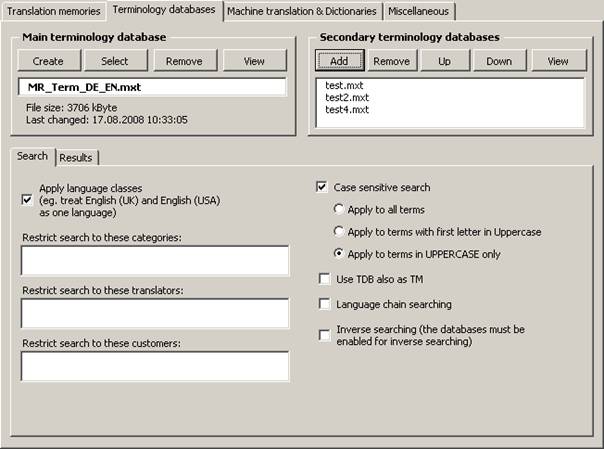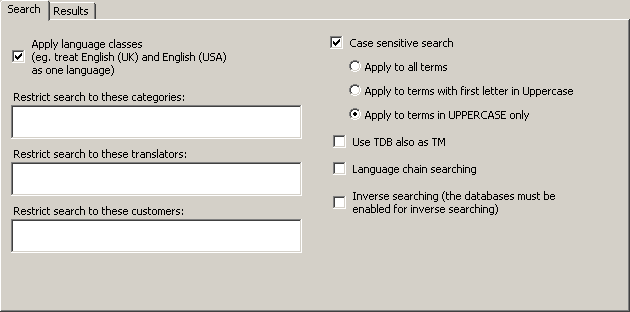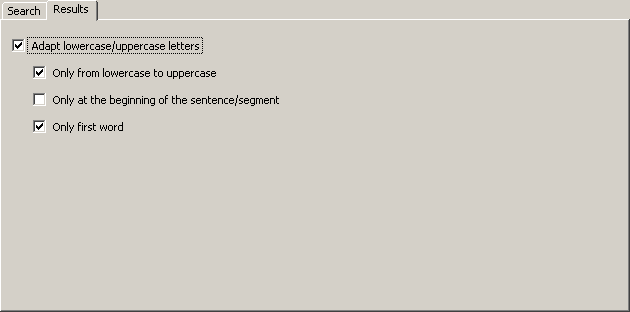
Terminology databases are configured via the Terminology databases tab:

In the following sections, the options are explained in detail.
Defining the Main TDB (Scout)
To select an existing TDB:
1. Click the Select button in the Main terminology database frame.
2. In the dialog box shown, select a database type (see Database Servers).
3. If you have selected the local database type, another dialog box will be shown. Select a TM/TDB, as appropriate.
To create a new TDB:
1. Click the Create button in the Main terminology database frame.
2. In the dialog box shown, select a database type (see Local MetaTexis Databases).
3. In the following dialog box, select a directory and define a name for the new TDB.
To remove a main TDB:
1. Click the Remove button in the Main terminology database frame.
To view the main TM/TDB:
1. Click the View button in the Main terminology database frame.
Defining Secondary TDBs (Scout)
To add a TDB to the list of secondary TDBs:
1. Click the Add button in the Secondary terminology databases frame.
2. In the dialog box shown, select a database type (see Database Servers).
3. If you have selected the local database type, another dialog box will be shown. Select a TM or TDB, as appropriate.
To remove a TDB from the list of secondary TDBs:
1. Click the Remove button in the Secondary terminology databases frame.
To move a TDB up or down in the list of secondary TDBs:
1. Click the Up/Down button in the Secondary terminology databases frame.
To view the secondary TDB:
1. Click the View button in the Secondary terminology databases frame.
TDB search options (Scout)
The TDB search parameters are very similar to the TM search parameters.
The Search tab contains the TDB search parameters:

The following settings can be performed:
∑ Apply language classes:
If this checkbox is checked, MetaTexis looks for language classes rather than for the language defined. There are several languages that have variants. For example, there are many variants of the English, French and Spanish languages. If language classes are applied, MetaTexis treats the variants of a language as the same language, e.g. English (UK) and English (USA) are treated as one language. So, if a TDB contains segments in different languages that belong to the same language class, they are all included in the search. On the other hand, if this checkbox is unchecked, MetaTexis only includes the segments in the same language as the source language of the MetaTexis document (see Document Options).
∑ Restrict search to these categories:
If you enter a category in this text box, the TDB search is restricted to segments with this category. You have to be careful with this command: Make sure that the category entered actually exists in the TDBs.
If you enter more than one category, they must be separated by a semicolon.
∑ Restrict search to these translators:
If you enter the names of translators in this text box, the TDB search is restricted to segments last edited by the specified translators. You have to be careful with this command: Make sure that the translators entered actually exist in the TDBs.
If you enter more than one translator, they must be separated by a semicolon.
∑ Case sensitive search:
If this checkbox is checked, the results of a TDB search are searched according to one of the following options:
▪ Apply to all terms
If this option is active, any term found must have the same lower/uppercase structure as the term in the segment.
For example: If the source segment contains the word "uno" in uppercase and the TDB contains the three terms "uno", "Uno" and "UNO", only "uno" will be displayed as TDB search result.
▪ Apply to terms with first letter in Uppercase
If this option is active, any term found with the first letter in Uppercase must have the same lower/uppercase structure as the segment.
For example: If the source segment contains the word "Uno" in uppercase and the TDB contains both "uno" and "Uno", only "Uno" will be displayed as TDB search result.
▪ Apply to terms in UPPERCASE only
If this option is active, any term found completely in UPPERCASE must also be completely in uppercase in the segment searched.
For example: If the source segment contains the word "UNO" in uppercase and the TDB contains both "uno" and "UNO", only "UNO" will be displayed as TDB search result.
∑ Use TDB also as TM:
If this option is checked, the TDB will not only be searched as TDB, but also as TM, that is, the terms in the TDB will be treated as TUs. This can further increase your translation efficiency, for example, when the TDB contains long phrases.
∑ Language chain searching:
If this option is checked, the search will be extended to find more TUs if the TM contains multi-lingual content. For example, letís assume that you are translating a text from English to French (EN->FR). If the TM contains TUs in the language combinations EN->IT and IT->FR, where one EN segment is very similar or identical to the segment currently searched, the TM search will usually not be successful because there is no EN->FR dataset in the TM. However, if the language chain searching is active, MetaTexis will look further. And if the IT segments are identical, MetaTexis will actually find the French translation of the Italian text and assign it to the English source text, and an EN->FR hit will be displayed. This search even works across TMs!
Moreover, if inverse searching is active, the language chain search even works if the language directions are mixed, e.g. MetaTexis will find a match if the TM has the TUs IT->EN and FR->IT.
∑ Inverse search (the databases must be enabled for inverse searching):
If this option is checked, the TDBs will also be searched for matches with the opposite language direction. This option only works if the database is activated for inverse searching and saving when it is created (see Local MetaTexis Databases). Combined with the language chain searching feature, this opens up amazing possibilities (see above).
TDB search results options (Scout)

The following settings can be performed:
∑ Adapt lowercase/uppercase letters:
When this option is checked, any inserted terminology is automatically converted to lowercase/uppercase, if appropriate.
▪ Only from lowercase to uppercase:
When this checkbox is checked, the terminology found is only converted from lowercase to uppercase, but not from uppercase to lowercase. For most language combinations, this checkbox should be checked.
▪ Only at the beginning of the sentence/segment:
When this checkbox is checked, the lowercase/uppercase conversion is only made for the first word of a sentence/segment.
▪ Only first word:
When this checkbox is checked, the lowercase/uppercase conversion is only made for the first word of a term/phrase found, but not for all words. That is, not all words in the translation are converted, but only the first one. If the checkbox is not checked, all words of the translation are converted only if all words of both the source text and the translation are lowercase or uppercase. If there is a mix of uppercase and lowercase words, only the first word is converted.